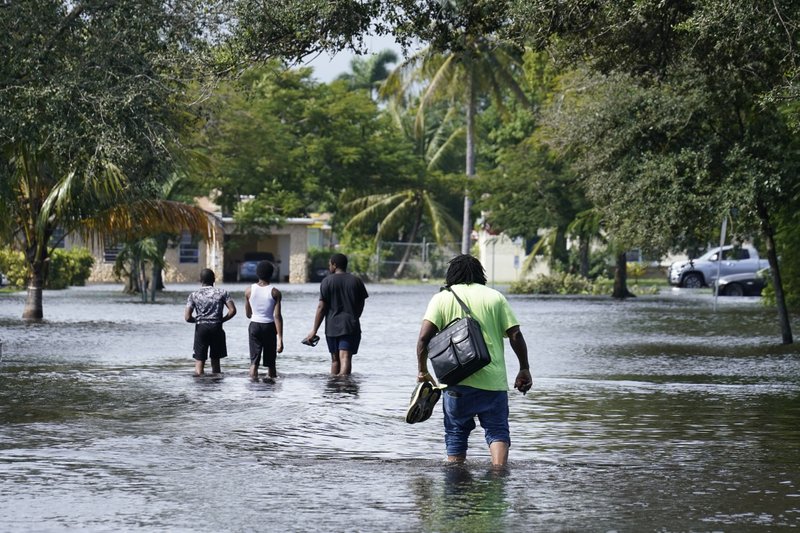Heavy rain from Tropical Storm Eta caused dangerous flooding Monday across Florida’s most densely populated urban areas, stranding cars and swamping entire neighborhoods with fast-rising water that had no place to drain.
The system made landfall in the Florida Keys and posed a serious threat across South Florida, which was already drenched from more than 14 inches (35 centimeters) of rain last month. Eta could dump an additional 6 to 12 inches (15 to 30 centimeters), forecasters said.
“It was far worse than we could’ve ever imagined, and we were prepared,” said Arbie Walker, a 27-year-old student whose Fort Lauderdale apartment was filled with 5 or 6 inches (13 to 15 centimeters) of water.
“It took us 20 minutes to navigate out of our neighborhood due to the heavy flooding in our area,” Walker added. Floodwaters also submerged half of his sister’s car.
Eta hit land late Sunday as it blew over Lower Matecumbe, in the middle of the chain of small islands that form the Keys. The storm moved into the Gulf of Mexico early Monday near where the Everglades meet the sea, with maximum sustained winds of 65 mph (100 kph). It was centered south of Naples, moving west-northwest at 13 mph (20 kph).
Forecasters said the system could intensify again into a minimal hurricane as it slowly moves up the southwest Gulf Coast, centered just far enough offshore to maintain its strength while dumping vast amounts of water across the lower third of the Florida peninsula.
Fort Lauderdale Mayor Dean Trantalis called it a 100-year rain event.
“Once the ground becomes saturated, there’s really no place for the water to go,” Trantalis said. “It’s not like a major hurricane. It’s more of a rain event, and we’re just doing our best to ensure that the people in our community are being protected.”
City officials dispatched some 24 tanker trucks with giant vacuums to soak up water from the past few weeks. Some older neighborhoods simply do not have any drainage. The city also passed out 6,000 sandbags to worried residents over the weekend, but water seeped into homes and stranded cars in parking lots and along roadways.
Randi Barry, 36, also woke up Monday to flooded streets outside her home in Fort Lauderdale, and joined her neighbors in helping people whose cars were stuck in high water.
“There are a lot of people with their doors open, getting furniture up to higher ground and trying to get water out of their homes,” Barry said. “Everyone is helping each other out a lot.”
A tractor-trailer was left dangling off the elevated Palmetto Expressway in Miami, the Florida Highway Patrol reported. The driver lost control on the wet, slick road and suffered minor injuries, CBS 4 in Miami reported.
“Please take this storm seriously,” urged Palm Beach County Emergency Management Director Bill Johnson. “Please don’t drive through flooded roadways.”
Miami-Dade County Mayor Carlos Gimenez said he was in frequent contact with county officials about the struggle to drain the flooded waters.
“In some areas, the water isn’t pumping out as fast as it’s coming in,” warned Miami-Dade Commissioner Jose “Pepe” Diaz.
Firefighters pulled a person from a car that had driven into a canal Sunday night in Lauderhill, north of Miami. The patient was hospitalized in critical condition, according to a statement from Lauderhill Fire.
In the Keys, the mayor ordered mandatory evacuations for mobile home and RV parks, campgrounds and other low-lying areas. School districts closed, saying the roads were already too flooded and the winds could be too gusty for buses to transport students. But the islands were spared any major damage, and officials expected shelters to close and schools to reopen by Tuesday.
Aside from a banyan tree that fell on a home and injured people inside, Key Largo was largely unscathed, Fire chief Don Bock said.
Eta also was not done yet with Cuba, just 90 miles south of Florida, where the storm continued to swell rivers and flood coastal zones on Monday. Some 25,000 people were evacuated with no reports of deaths, but rainfall continued, with total accumulations of up to 25 inches (635 mm) predicted.
Eta initially hit Nicaragua as a Category 4 hurricane and wreaked havoc from Mexico to Panama. Authorities were still surveying the damage Monday after days of torrential rain. Official death tolls totaled at least 68 people, but hundreds more were missing and many thousands were in shelters after flash floods tore through communities of improvised homes on unstable mountainsides.
(AP)











